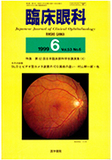Japanese
English
- 有料閲覧
- Abstract 文献概要
- 1ページ目 Look Inside
(P3-2-17) 涙嚢鼻腔吻合術(DCR)において,侵襲を少なくするためには骨窓を小さく作る必要があるが,小さすぎる胃窓は吻合孔の再閉塞の危険がある。筆者らは慢性涙嚢炎の10例10側にone flap DCRを行い,できた吻合孔を鼻腔内視鏡を使用して経時的に観察した。骨窓は平均9×10mmのものを形成し,ヌンチャク型シリコーンチューブ(N-ST)とスポンゼルまたはゼルフォームを留置した。術後1〜5か月ごろまでに吻合孔は収縮し,2例では吻合孔の中に肉芽がみられた。術中骨窓が前篩骨洞に開放した1例は再閉塞したが,残りの9例は術後平均7か月目には平均1.4×1.8mm径の円形または楕円形の吻合孔となり固定し,これらは良好な涙導機能を有した。鼻腔内視鏡の観察により,9×10mm径の骨窓を形成するDCRで,形態的にも十分な大きさの吻合孔を形成できることが明らかになった。
We performed one-flap dacryocystorhinostomy in 10 cases of chronic dacryocystitis. The osteotomy measured 9×10mm and was stented with a nunchaku- style silicone tubing and spongel or gelform. Nasal endoscopy showed the intranasal rhinostomy to gradually decrease for 1 to 5 months after surgery. A small granuloma grew at the site of rhinostomy in 2 cases. The rhinostomy became obstructed in one case in whom the site of osteotomy anastomosed to the anterior ethmoid sinus. In the other 9 cases, the rhinostomy site became circular or oval, measured 1.4×1.8mm in average and resulted in normal tear drainage. Above endoscopic findings show the effectiveness of osteotomy measuring 9×10mm during dacryocystorhinostomy.

Copyright © 1999, Igaku-Shoin Ltd. All rights reserved.


